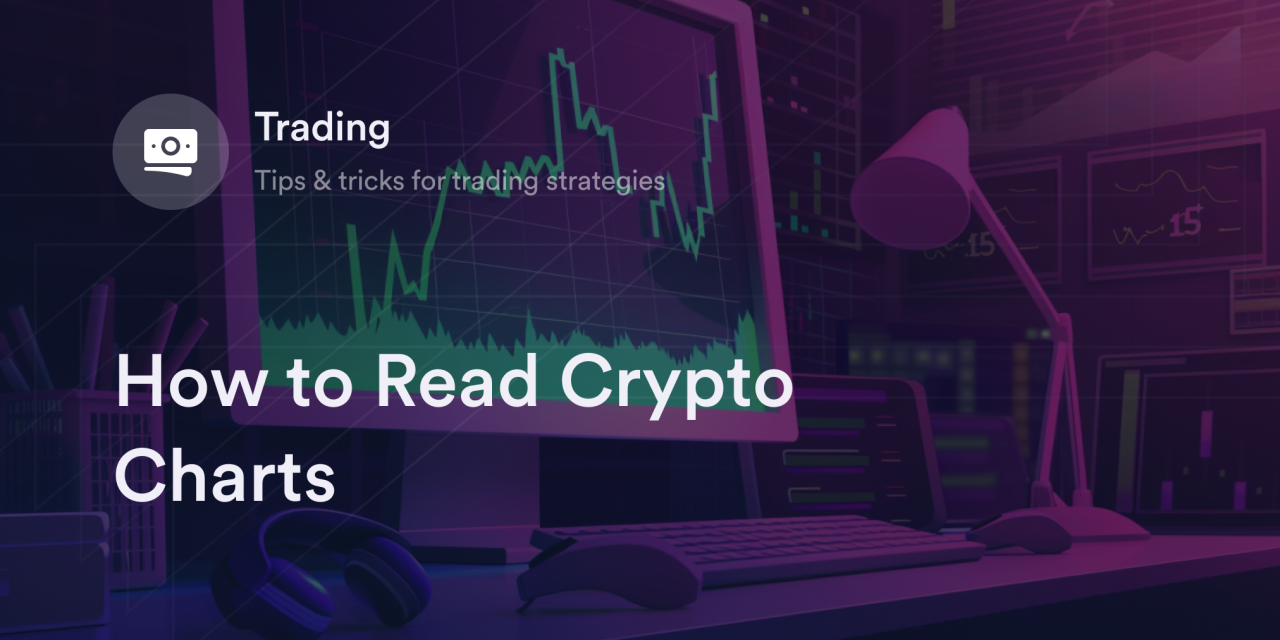


Seasoned traders are well-aware of cryptocurrency’s wild price swings––one day, a digital currency seems to skyrocket, but a few days later, it’s plunging more than 20%.
But to an untrained eye, the lines on a cryptocurrency’s price chart look completely random. And after seeing these volatile moves in the crypto market, some traders are skeptical about reviewing historical chart patterns. So how does anyone use this seemingly irrational price data to help form a strategy to buy or sell digital assets?
As illogical as crypto price charts may appear, traders use them daily to place orders in the crypto market. They use technical tools to reveal critical price levels and patterns in their target cryptocurrency’s chart.
Here are the basic tools for reading crypto charts to predict future prices, manage risk, and make informed decisions. But first, let’s understand a crypto price chart’s fundamentals.
What Is a Crypto Price Chart?
A crypto price chart is a graph with detailed information on a cryptocurrency’s past and present trading activity. And most have time frames (such as hours, days, or weeks) on the horizontal axis and prices (typically quoted in U.S. dollars) on the vertical axis. There are two primary ways charts represent a cryptocurrency’s average price:
Line charts: These charts use a solid line to highlight the median closing price for a cryptocurrency over time. The closing price is a crypto asset’s final trading cost within a predefined period.
Candlestick charts: The candlesticks in this chart pattern are rectangles symbolizing trading activity for a cryptocurrency within a specific time frame. For example, on a daily candlestick chart for Bitcoin (BTC), each candlestick is equivalent to 24 hours of BTC price fluctuations.
Of these two patterns, line graphs are more intuitive to read, while candlestick charts include more details.
Crypto traders access more data points by adjusting the average times on candlestick charts and analyzing each block of trading history. Because candlesticks give traders a clearer glimpse into trading activity on multiple time frames, crypto traders prefer these over line charts when analyzing the marketplace.
Why Do Traders Use Price Charts?
Price charts help traders visualize the historical and current asset price activity, such as cryptocurrencies. Although analyzing past trading data can’t guarantee future price performance, short-term traders use these charts to develop trading strategies, set indicators, and open or close their positions.
In fact, there’s an entire field of market research called technical analysis dedicated to studying chart data. Unlike fundamental analysis, technical analysis relies on chart patterns, statistics, and trendlines to predict future prices and set up trades. While a fundamental crypto analyst researches a coin’s history, network activity, and circulating supply, technical analysts use charting tools to pinpoint the best prices to enter and exit a trade. Traders using technical analysis need detailed chart data to develop their trading thesis and choose the prices they’re most comfortable with when buying or selling an asset.
Essential Features of A Crypto Chart
Seeing a candlestick crypto chart for the first time is overwhelming. However, every trader needs to recognize the following features to understand what they’re looking at:
Trading pair: This is a set of two assets that compare prices on a chart. Most often, crypto price charts pair a cryptocurrency with a fiat currency, such as the U.S. dollar, for transparent price comparisons (e.g., a “BTC/USD” pair quotes BTC’s prices in terms of U.S. dollars). However, traders can compare cryptocurrencies to other assets on their trading platform. For instance, a crypto trader may use a “Bitcoin/Ethereum (ETH)” trading pair to visualize ETH’s relative value compared to BTC.
Unit of time: Each price chart tracks crypto prices with different time durations on the horizontal axis. For example, if a price chart has an “hourly” setting, each candlestick represents one hour of trading data. Crypto trading platforms like dYdX let traders adjust these time frames to see the data they’re most interested in.
Candlesticks: As mentioned, candlesticks are thin rectangles on a price chart that show price activity for a crypto asset within a selected time frame, such as an hour, a day, or a week. If a candlestick is green, its final price closes at the top of the rectangle, whereas red candles close at the bottom. Sometimes, these candlesticks also have straight white or gray lines on the top and bottom called “wicks.” A wick signifies how far a crypto’s price trades within a given session but not where it opened or closed.
Trading volume: Volume measures the total amount of a cryptocurrency traded for within a chart’s selected time frame. Traders find this data in a small bar graph below the central price chart. If a bar on the volume chart is green, there are more buyers than sellers for a cryptocurrency. Conversely, red bars mean more people sell cryptocurrency than buy it. The higher each bar is on a volume chart, the more activity there is in the crypto market.
How to Read Candlestick Charts in Crypto
To understand candlestick charts, here’s an example. Suppose a trader looks at a candlestick on a daily Bitcoin chart with the following features:
Green color
A top wick extending from $22,000 to $22,100
A solid rectangle extending from $21,500 to $22,000
A bottom wick extending from $21,500 to $21,050
Here, BTC opened at $21,500 and closed at $22,000 within a 24-hour window. Although BTC’s price traded as low as $21,050 and as high as $22,100, the trading activity’s bulk happened between $21,500 and $22,000.
Now, let’s suppose the above candlestick was red rather than green. In this scenario, $22,000 would be the trade’s opening price, and $21,500 would be closing. In other words, Bitcoin fell in price by $500 by the end of 24 hours. The wicks still represent BTC’s trading range in this session but not its opening or closing price.
Where Can I See Crypto Charts?
Centralized exchanges (CEXs) and decentralized exchanges (DEXs) provide real-time price charts for all cryptocurrencies on their platforms. For example, traders on dYdX can choose any available crypto asset to view past and present price patterns. The company also has dozens of tools and different time settings to help traders visualize price data from multiple angles.
Besides crypto exchanges, a wealth of third-party websites offer live cryptocurrency charts. For instance, crypto price aggregators, such as CoinMarketCap and CoinGecko, provide price charts for many crypto assets. People who don’t have an account on a crypto exchange can use these websites to assist in performing preliminary technical analysis.
How to Try to Predict Prices with Crypto Charts
The technical analysis field is vast, and every trader has a unique set of tools they prefer to analyze price data. However, new traders could use a few standard strategies to get started analyzing crypto price charts:
Trendlines: Trendlines are horizontal lines traders draw across the bottom and top of candlesticks to identify the general pattern of a cryptocurrency’s prices. If these candlestick patterns tilt up, the market will have more buyers (aka a bullish pattern). However, trendlines moving down suggest sellers overtake buyers (aka a bearish pattern). Trendlines also identify critical levels where cryptocurrencies tend to bounce both on the bottom (known as support levels) and top (called resistance levels) of a price range. Traders draw trendlines to recognize bullish versus bearish patterns and key prices to enter or exit their trades.
Moving averages (MAs): MAs are similar to trendlines, but these horizontal lines symbolize an asset’s median closing price over a given time frame. For example, a 50-day MA for Bitcoin maps the average price per BTC over the past 50 days. Generally, if a crypto asset is below most MAs, it’s in a bear market. In contrast, when cryptocurrencies break above their MAs, it’s more likely that traders are bullish.
Relative strength index (RSI): The RSI is a line graph below a crypto’s central price chart indicating how fast traders bought or sold a crypto within a set time frame. As the RSI rises closer to 100, there’s a good chance people overbought the cryptocurrency, and now it’s due for a price fall as traders take profits. Conversely, RSI scores closer to 0 signify there are virtually no buyers for a cryptocurrency, meaning it may be a good value.
Fibonacci ratios: Named after Italian mathematician Leonardo Fibonacci, Fibonacci ratios are percentages that perfectly measure many aspects of the natural world (e.g., the center of hurricanes, sunflowers, and Nautilus seashells). Interestingly, traders often use Fibonacci levels to predict where a virtual currency’s price will likely fall or rise, identifying its support and resistance levels. The Fibonacci ratios go as follows: 23.6%, 38.2%, 50%, 61.8%, and 100%.
Study Crypto Chart Patterns on dYdX
On dYdX’s decentralized exchange, traders can access hundreds of technical indicators and candlestick chart patterns to help them analyze a cryptocurrency’s price performance. From moving averages and Bollinger bands to RSI and the Ichimoku cloud, traders can use countless technical tools on dYdX’s platform. Traders should keep in mind, however, that other forms of crypto charts may exist as well as other ways to read them than as suggested here.
For more educational articles on technical analysis and trading cryptocurrencies, head to the dYdX Academy. For more information about the product itself, check out dYdX’s blog!
Also, don’t forget dYdX offers traders low-fee perpetuals trading for Bitcoin, Ethereum, and dozens of altcoins.
Start trading on dYdX today!
Disclaimer
The content of this article (the “Article”) is provided for general informational purposes only. Reference to any specific strategy, technique, product, service, or entity does not constitute an endorsement or recommendation by dYdX Trading Inc., or any affiliate, agent, or representative thereof (“dYdX”). Use of strategies, techniques, products or services referenced in this Article may involve material risks, including the risk of financial losses arising from the volatility, operational loss, or nonconsensual liquidation of digital assets. The content of this Article does not constitute, and should not be considered, construed, or relied upon as, financial advice, legal advice, tax advice, investment advice, or advice of any other nature; and the content of this Article is not an offer, solicitation or call to action to make any investment, or purchase any crypto asset, of any kind. dYdX makes no representation, assurance or guarantee as to the accuracy, completeness, timeliness, suitability, or validity of any information in this Article or any third-party website that may be linked to it. You are solely responsible for conducting independent research, performing due diligence, and/or seeking advice from a professional advisor prior to taking any financial, tax, legal, or investment action.
You may only use the dYdX Services in compliance with the dYdX Terms of Use available here, including the geographic restrictions therein.
Any applicable sponsorship in connection with this Article will be disclosed, and any reference to a sponsor in this Article is for disclosure purposes, or informational in nature, and in any event is not a call to action to make an investment, acquire a service or product, or purchase crypto assets. This Article does not offer the purchase or sale of any financial instruments or related services.
By accessing this Article and taking any action in connection with the information contained in this Article, you agree that dYdX is not responsible, directly or indirectly, for any errors, omissions, or delays related to this Article, or any damage, injury, or loss incurred in connection with use of or reliance on the content of this Article, including any specific strategy, technique, product, service, or entity that may be referenced in the Article.







